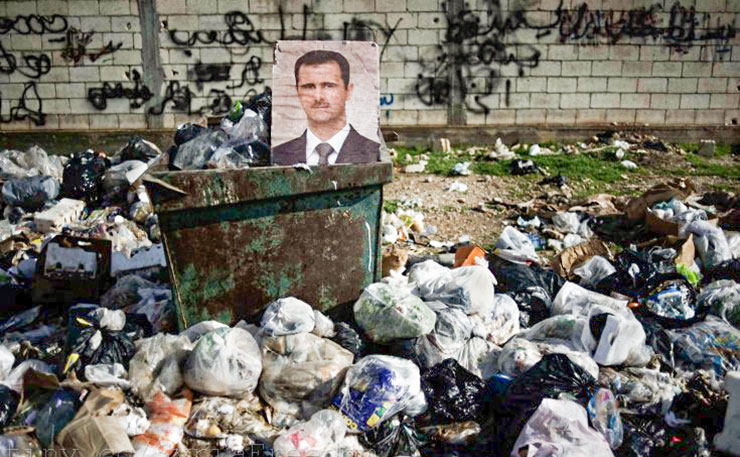The second round of international peace talks to secure an end to the conflict in Syria have ended.
Lakhdar Brahimi, the UN-Arab League mediator, has apologised to the Syrian people after face-to-face talks between the Syrian Government, led by Syria’s ambassador to the UN Bashar Ja’afari and Foreign Minister Walid Moallem, together with representatives of the rebel Syrian Opposition Coalition including its president Ahmad al-Jarba, were cut off after just thirty minutes.
The Geneva II peace talks, like Geneva I before them, failed to bring any meaningful respite. Now governments and policy makers must change their focus to assisting and protecting Syrian civilians rather than wasting time extracting promises at high-level negotiations that neither party has any intention of honouring.
After over 1000 days of conflict, the prioritisation of the needs of Syrian civilians has been insufficient. The death toll from the Syrian conflict has climbed to a staggering 120,000 dead with 6-7 million people becoming refugees or being internally displaced. Cities such as Homs and Daraa have been besieged. Areas such as the Palestinian Yarmouk refugee camp have been cut off from both aid and food supplies, causing starvation and needless death.
Add to this the use of chemical weapons in the civilian area of the Ghouta, barrel bombing (drums packed with explosives and shrapnel dropped from the sky) of Aleppo’s residential areas and medieval punishments such as public beheadings and floggings by extreme rebel groups such as the Islamic State of Iraq and al-Sham (ISIS). Efforts need to be made by the international community to secure much needed aid, food and some level of basic security, and force all opposing elements to respect, even to the most basic extent, the laws of armed conflict which mandate respect for civilian life.
During times of war, violence can be ubiquitous. In order to minimise the harm war can have on civilians international humanitarian law makes explicit and specific distinctions between civilians and combatants. While this line has become blurred in recent times, the fundamental principle has not changed — “persons taking no active part in the hostilities … shall in all circumstances be treated humanely…”
Small organisations such the Syrian Legal Development Programme have sprung up in order to provide necessary training to insurgents inside Syria on important distinctions such as this. Groups such as the SLDP are helping rectify the almost complete disregard for civilian life that has so far characterised the Syrian conflict.
And there are other options that will provide immediate relief and protection. One such possibility is the establishment of humanitarian corridors. These are areas that have been temporarily demilitarised in order to allow the safe transit of humanitarian aid and refugees. They are often associated with a no-fly zone. As a direct response to an anticipated attack on Benghazi by Colonel Muammar Qaddafi, the UN Security Council authorised “all necessary measures” be used to protect civilians in Libya. This included the establishment of a no-fly zone that banned all flights in Libyan airspace except those for humanitarian purposes.
Policed by NATO, this version of a humanitarian corridor was specifically set up in order to help prevent a humanitarian disaster and protect civilians. But so far Russia has blocked any Security Council resolution pertaining to Syria that leaves such a possibility open, because the downfall of the Qaddafi regime in Libya was undeniably linked to the military operations that the Security Council resolution sanctioned. Russia is therefore cautious of allowing anything even remotely similar in Syria.
With this in mind, local ceasefires are perhaps a more nuanced and targeted way of achieving some immediate relief for civilians in certain areas. Such cease-fires are based heavily on the immediate political and military environment as well as the needs of the population in which they are made. They mostly involve negotiations between regime officials who have connections to the area and local residents and rebel fighters.
While such ceasefires may not be possible in complex areas, they have already brought some respite to the Damascus suburbs of Barzeh, Moadamiya, Bibilla, Bait Sahem, and Dumayr. The evacuation of 700 civilians from besieged Homs during a three-day ceasefire was one of Geneva II’s only success stories.
The advantages of dialogue at the local level mean that the immediate needs of the local population, whether they are medical aid or food, can be directly taken into account and the terms of the ceasefire negotiated accordingly. They also put local leaders and rebels in charge of the security and policing of their own areas meaning that such areas would already have a level of organisation and autonomy that would make them easier to absorb into any eventual transitional state apparatus.
Another possibility is the revival and increase of funding from external sources such as the US, Europe and other regional allies via the Syrian Opposition Coalition to local civilian administrations that are functioning in some areas like Aleppo. As a report by the International Crisis Group suggests, rivalry between two of the Coalition’s major sponsors, Saudi Arabia and Qatar, has only increased divisive intra-Coalition dynamics and has effectively brought its activity, at certain times, to a halt.
Cooperation and a coordinated front in supporting local administrations working on the ground in Syria, coupled with additional financial and physical resources, would be a direct way of boosting the Coalition’s capabilities inside Syria, and in the process countering the dominance of jihadis and Islamists. Just a few days ago the US stepped up financial support to the Coalition, handing over millions of dollars to help pay fighters’ salaries. They should also require that the Coalition funnel the money directly to local administrative bodies that are best placed to spend it in relation to the needs of their communities.
Any agreement reached at Geneva II was destined to fail. The regime entered the negotiations in a position of strength – it was strong militarily, its allies (namely Iran and Hezbollah) highly committed and it seemed to have discovered new depths to its already high capacity for brutality. In short, Assad and the regime had no real reason to compromise.
On the rebel side, the Syrian Opposition Coalition present at the talks represented only a small portion of the thousands of rebel factions currently active inside Syria. Any concessions it could potentially extract were bound to be opposed. Just as Geneva II began, US President Barack Obama acknowledged that diplomatic efforts to resolve the Syrian conflict are far from achieving their goals, “but the situation is fluid and we are continuing to explore every possible avenue”.
These avenues need to be more modest forms of dialogue and negotiation that offer greater immediate protection for Syrian civilians rather than the grand winner-takes-all scenario of international peace talks.
Donate To New Matilda
New Matilda is a small, independent media outlet. We survive through reader contributions, and never losing a lawsuit. If you got something from this article, giving something back helps us to continue speaking truth to power. Every little bit counts.





